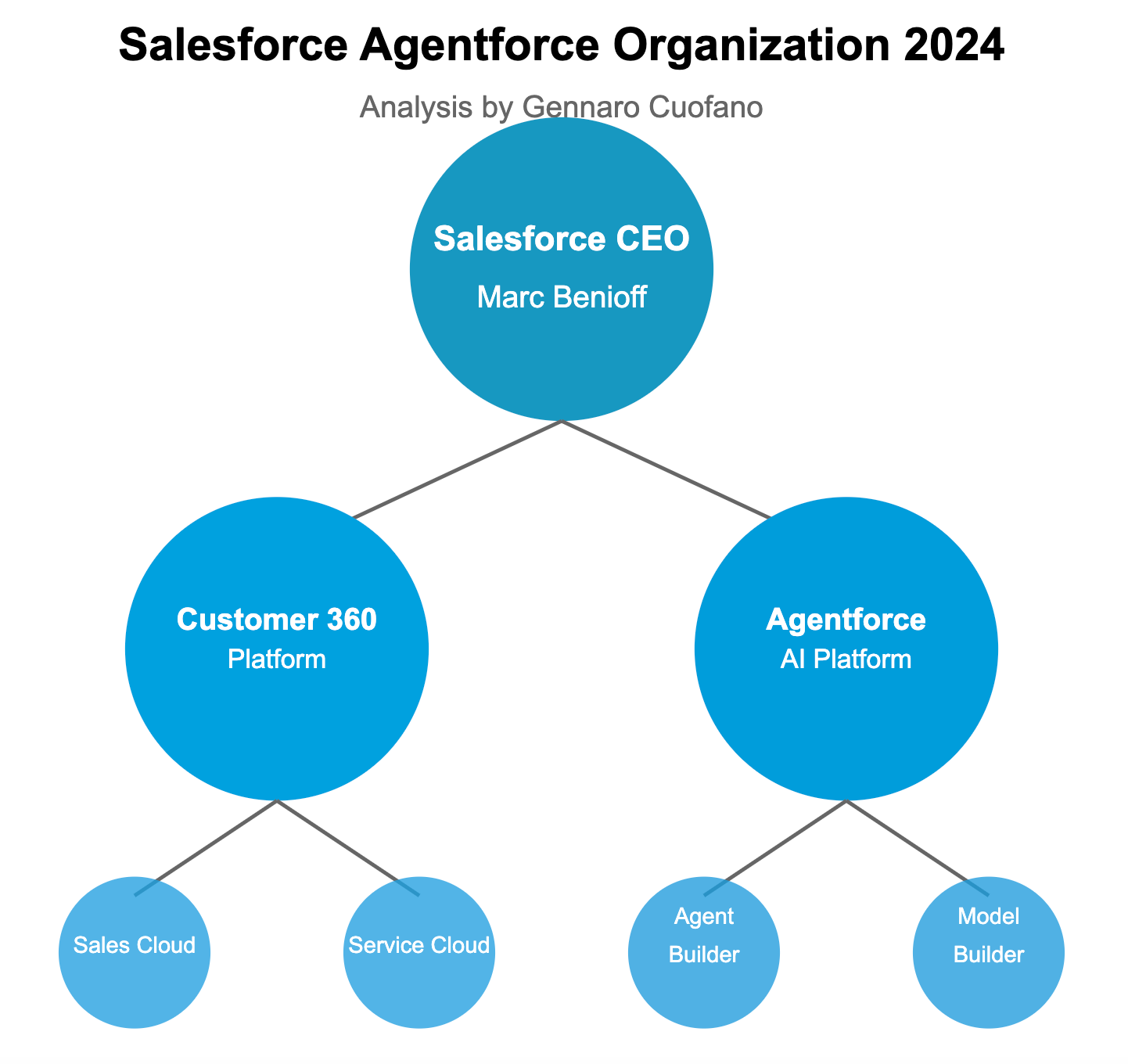Capital Concentration In The AI Era
Currently, the AI market is hugely concentrated around a few winners, which move the whole market, and these mostly sit on the foundational and hardware layers.
You’ll find this data clearly shown on my dashboard.
However, as I’ll show, another layer of the market is finally opening up substantially: that of vertical AI players.
Those specialized generalist companies are trying to build a valuable AI to tackle a specific vertical (accounting, finance, healthcare, and so forth).
In December 2022, I explained exactly that; when I referred to the middle layer of the AI stack, I was referring to vertical AI companies.
I also raised a warning on Salesforce.
Fast forward over two years, it seems SF has gotten the message and re-organized the whole company to the AI, betting it all on AI Agents.
It is meant as co-pilots or autonomous orchestration workflow to automate tasks like customer support, which is the first use case SF is aggressively tackling in a bloody fight with Microsoft.
That’s unsurprising, as the market is still under development, and the capital dynamics are not that different from how they played out in the previous technological cycle.
Yet, there is a more skewed effect in the current AI paradigm.
The “Wow-Effect” - The Hedonistic Treadmill And The Hedonic Decline
The hedonistic treadmill or hedonic adaptation is a mental phenomenon where humans relatively quickly tend to tend toward the average level of happiness after they have experienced an outsized positive outcome.
It seems we have already taken for granted something that only three years back seemed impossible.
Starting in the 2010s, up to the “ChatGPT Moment” (November 30, 2022), neural nets were promising for a few researchers who still believed in the field.
On the other hand, it’s worth reminding you that neural nets could not achieve such a level of “cognitive abilities” (in terms of output, as we have little clue of what goes in the black box).
That caught everyone off guard.
Also, people like me have been seeing the field's evolution for the last decade.
That change of pace, that surprising feat, and the still-evolving AI landscape, which went through three phases, that we’re still seeing playing out.
Since the current AI paradigm, which I’m simplifying as “deep neural nets built on a transformer architecture, pre-trained on top of thousands of GPUs, by feeding the whole web,” we went through three main phases:
Pre-training phase.
Post-training phase.
Reasoning phase.
To be clear, while all these three phases will continue to develop in parallel, each might become the key driver for the next adoption phase.
Each of them comes with its own technical paradigms and business models.
It’s just part of human nature to take something as impressive as these AI models for granted.
It’s our nature to experience a “wow effect” and integrate it into our daily lives, taking it for granted.
However, the actual psychological test of whether these things are so valuable is when you lose the chance to use them (hedonic decline).
I’d assume that if OpenAI’s ChatGPT disappeared, it would madden many people, and many professionals would not be able to operate at the same level.
In short, while the “wow effect” easily passes, turning into a hedonic treadmill, you go into hedonic decline as soon as you lose that thing you took for granted.
You can do it with any extremely valuable technology you take for granted.
And that’s not the end of the story; as new reasoning models come to the market, making these capabilities cheaper and more scalable, we’ll see a growing set of commercial use cases emerge in many vertical niches.
For the same token, we’ll also see the same pattern of the “wow effect” followed by the hedonic treadmill.
That’s also why, non-trivially, releasing these AI tools to the public is critical to make sure we take them all for granted rather than treating them as a terminator.
When things appear in our imagination, they always seem scary, vs. when we experience them, in a sort of never-ending collective psychological cycle, which looks like that.
I’ll leave the psychological effect of the AI cycle to another issue, for now let’s get back to business…
This is part of an Enterprise AI series of (possibly) daily short pieces to tackle many of the day-to-day challenges you might face as a professional, executive, founder, or investor in the current AI landscape.
All these pieces are freely available to you. If you find the piece isn’t enough to help, you can contact me once you join in as a Founding Member.
A Consumer-First Paradigm, But What Now?
In addition, contrary to many other paradigms, which started from enterprise and then slowly cascaded to consumers, these large enterprise businesses financed the balance sheets of startups, who slowly then quickly moved downstream.
This current paradigm is moved all the way around.
ChatGPT has been the fastest-adopting consumer app, faster than TikTok. Indeed, for how bizarre a name might be (a nerdy one), you can do “the mother test” right now by asking her whether she knows what that is.
Thus, we have had an AI paradigm, catching most of the professionals in the field off-guard while giving these AI tools to hundreds of millions of people across the world almost overnight.
That has created a FOMO effect for enterprise businesses that are still playing catch-up!








